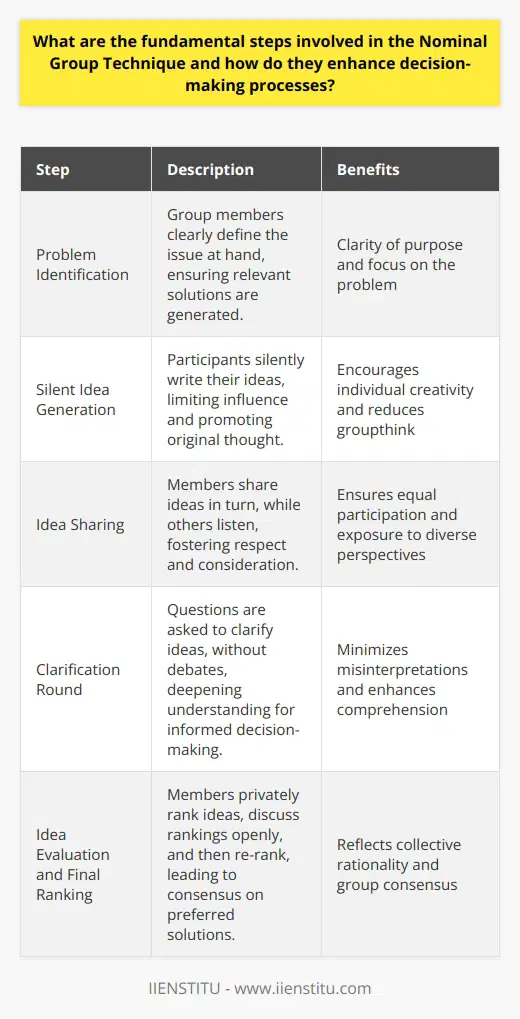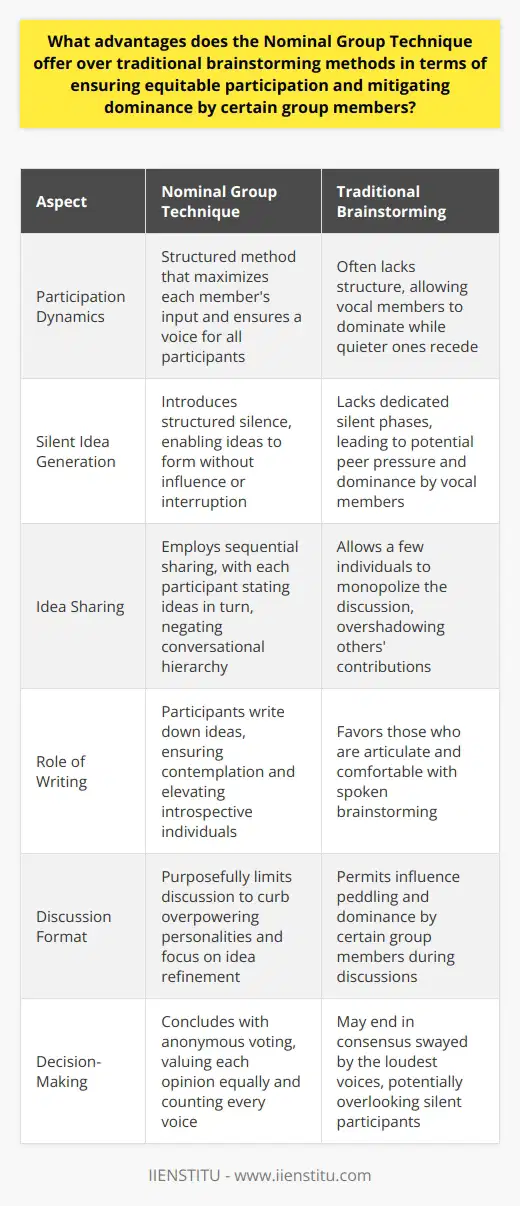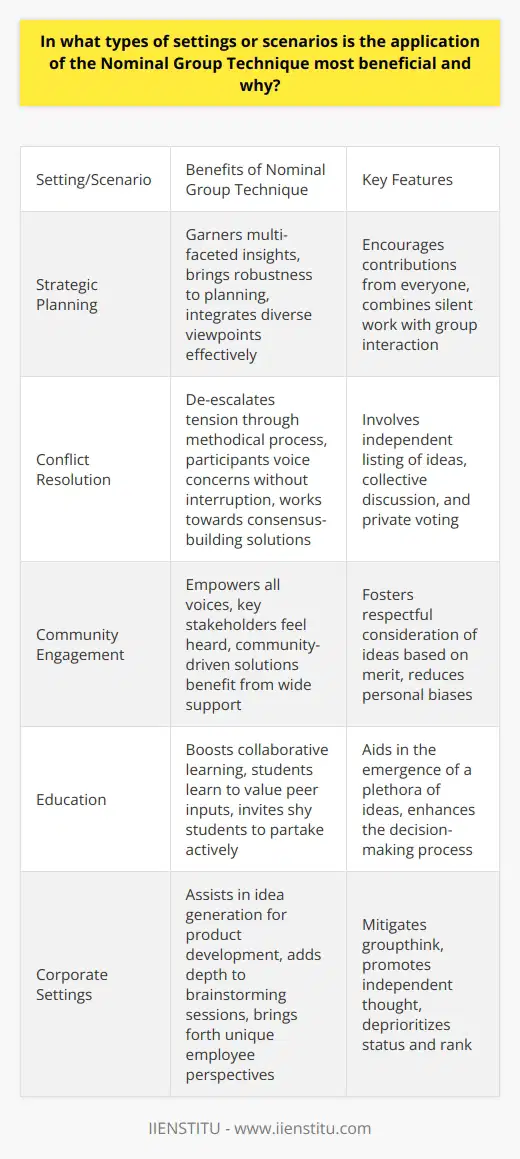
The Nominal Group Technique (NGT) is a structured method for group brainstorming that encourages contributions from everyone. As organizations and teams increasingly rely on collaborative efforts to solve complex problems, the application and importance of structured decision-making tools such as NGT have gained prominence.
This technique is designed to maximize input from all group members while minimizing some of the common pitfalls associated with group interactions, such as the dominance of a single member or the under-representation of introverted personalities.
In this article, we will delve into NGT's definition, execution, and potential for empowering group decision-making processes.
Understanding the Nominal Group Technique
NGT is not only a method but also a philosophy in problem-solving. We often see organizations and teams tackle issues without a systematic approach, leading to incomplete solutions or problems that resurface.
Online certificate programs in problem-solving courses embrace the NGT philosophy, ensuring a structured method is applied in addressing challenges. These programs are designed to equip learners with a systematic approach to problem-solving, preventing the recurrence of issues and fostering more effective solutions.
NGT offers an alternative path bolstered by thorough analysis and collective wisdom. The approach emphasizes the importance of every team member's perspective and strives for a well-rounded decision-making process.
Elements of Nominal Group Technique
The Silent Idea Generation
NGT begins with individual silent reflection. Unlike open-ended brainstorming sessions, NGT asks participants to quietly write down their ideas. This phase eliminates immediate criticism and allows each participant to develop thoughts without influence. By fostering an environment where everyone's input is initially developed independently, creativity and originality take centre stage, and the allure of groupthink fades.
Failure Tree Analysis: Effective Approach for Risk Assessment
Total Productive Maintenance (TPM): A Comprehensive Guide to Improved Efficiency
Round-Robin Feedback
After capturing ideas independently, the round-robin stage provides a systematic means for each individual to contribute. In this phase, facilitators invite participants to share their ideas one at a time in a circular fashion, which significantly reduces the risk of more assertive voices overshadowing quieter members. This impartiality is crucial – by nature, not popularity, ideas should flow into the collective pool for consideration.
Group Discussion
Once all ideas are shared and made visible to the group, an open discussion ensues. Each idea is considered, clarified, and challenged - constructively. It is in this back-and-forth that the collective intelligence of the team is harnessed. Group members are encouraged to express their insights, enabling a wealth of perspectives to shape the outcome.
Ranking or Voting
Finally, the participants are asked to rank or vote for the ideas. This structured decision-making ensures that the focus lies on the most favored or viable solutions, as determined by the collective judgement of the group. NGT's systematic approach culminates in a priority list reflective of the group's consolidated viewpoints, providing a clear direction for actionable steps.
The Process of Applying NGT
To successfully implement NGT, it begins with meticulous preparation. Facilitators tasked with overseeing NGT sessions must identify clear objectives, choose participants with diverse and relevant expertise, and create an environment conducive to open, yet structured, exchanges.
Preparation for NGT Session
Before diving into an NGT session, parameters must be set. These include a well-defined question or problem statement, a suitable physical or virtual environment for the session, and a set of rules that prioritize equity in voice and representation among participants. Proper preparation lays the groundwork for an effective NGT session, aligning all members towards a common goal.
Implementing the Four Key Elements of NGT
A precise implementation of the four stages of NGT is crucial. This involves establishing clear instructions for each phase, timing each activity, and seamlessly transitioning from one step to the next. Participants need to understand their roles and the expectations in each phase for the entire NGT process to be effective.
Guided Steps and Procedures
Each step of the NGT should be executed in a methodical and disciplined manner. The facilitator plays a vital role in making sure that each phase is conducted within the stipulated timeframe and that the discussions remain focused on the main issue. The success of NGT relies heavily on adherence to the sequential process and the diligent application of each stage.
Facilitation and Moderation in NGT
Strong facilitation is paramount. A skilled facilitator brings impartiality, guides the session through potentially contentious discussions, and manages time. The role of the facilitator is to ensure that the group maintains momentum and stays on course, all while creating a respectful and constructive dialogue environment.
Strengths and Limitations of NGT
NGT boasts a number of benefits. Its structured nature can bring order to chaotic brainstorming sessions and ensure that quieter group members have a voice. The process leads to well-considered decisions with a clear rationale behind them, which can increase the buy-in from all stakeholders involved.
Benefits and Advantages of Using NGT
The advantages of NGT lie in its democratic process and its ability to minimize the impact of dominant personalities. Furthermore, because it taps into the collective intelligence of a group, NGT can yield more innovative and comprehensive solutions to complex problems. The resulting commitment to the decision is often stronger because every group member has had the opportunity to contribute and be heard.
Drawbacks and Potential Challenges
Like all methods, NGT has its limitations. It can be time-consuming, and without expert facilitation, groups might struggle to reach a conclusion. Situations that require rapid decision-making might not be suitable for the NGT due to its structured and deliberate pace. A facilitator must be adept at ensuring the process does not become mired in excessive debate.
Guidance for Effectively Managing These Challenges
An experienced facilitator can help to mitigate many of NGT's potential pitfalls. Clear instructions, time management, and the ability to synthesize and summarize points are crucial skills. Additionally, adapting the NGT to the unique context of each problem can enhance its effectiveness while maintaining the integrity of its structured approach.
Practical Examples of NGT Application
Real-world implementation of NGT provides insight into its versatility across different contexts. From boardrooms to community centers, NGT has informed decisions that range from strategic planning to public policy.
Case Study of NGT in Corporate Decision-Making
In corporate settings, NGT has been used to converge on strategic decisions, such as product development or market entry strategies. By assembling cross-functional teams and orchestrating an NGT session, businesses have been able to amalgamate insights from different departments, fostering innovative approaches that might not have emerged from a conventional meeting setup.
NGT use within an Educational Department
Educational institutions have employed NGT to involve faculty in curriculum development and to address administrative challenges. It harnesses the diverse experiences of instructors to improve academic programs and operations, illustrating NGT's potential in collaborative, intellectual environments.
Role of NGT within a Public Health Context
Public health organizations have used NGT for policy development and program prioritization. Especially in areas where stakeholder input is critical, NGT helps balance expert opinion with community needs, ensuring that health initiatives are both evidence-based and socially responsive.
Comparison of NGT with Other Decision-Making Techniques
When compared with other decision-making strategies, NGT presents unique features that may suit certain scenarios better than others. It is a valuable tool with distinctive attributes that set it apart.
Distinctive Characteristics of NGT
NGT's structure and emphasis on egalitarian participation distinguish it from less formal group discussion methods. It allows for individual thought, which is systematically integrated into the group's framework, resulting in decisions that are collectively owned by the group.
Comparison with the Delphi Technique, Brainstorming, and Consensus Building
While brainstorming is an open-ended, free-for-all idea generation approach, NGT is more structured. The Delphi technique, on the other hand, involves rounds of questionnaires to a panel of experts and is more detached as opposed to the live interaction in NGT. Consensus building, while also aiming for mutual agreement, is typically less structured than NGT and may not always provide every participant an equal voice.
Factors to Consider When Choosing a Method
Selecting a decision-making method depends on factors such as the group's size, the complexity of the problem, time considerations, and the need for participant anonymity. The strengths of NGT make it a credible choice, especially when the objective is to integrate diverse ideas and achieve democratic decision-making.
The Nominal Group Technique stands out as an efficient tool for decision-making, particularly in scenarios that demand comprehensive involvement and the synthesis of varied perspectives. While NGT's methodical approach can be applied across multiple contexts, its success hinges on strong facilitation and an appreciation for the structured process it entails.
By embracing NGT, teams and organizations can foster inclusive environments where every member's view is considered, leading to enriched solutions and stronger consensus. In the ever-evolving landscape of group dynamics, NGT remains a relevant and powerful instrument for collective decision-making.
Frequently Asked Questions
What are the fundamental steps involved in the Nominal Group Technique and how do they enhance decision-making processes?
The Nominal Group Technique (NGT) improves decision-making. It fosters structured, participant-driven discourse. NGT ensures equitable input from all members.
Understanding Nominal Group Technique
The technique thrives on its steps. Each step brings a unique value.
Problem Identification
Problem identification commences the process. Group members are clear on the issue at hand. Clarity ensures relevant solutions.
Silent Idea Generation
Participants write ideas silently. This limits influence and promotes original thought.
Idea Sharing
Members share ideas in turn. All members listen. This fosters respect and consideration.
Clarification Round
Questions clarify ideas. No debates occur here. Understanding deepens for informed decision-making.
Idea Evaluation
Members privately rank ideas. Rankings reflect personal assessments of solutions.
Discuss Rankings
The group discusses rankings openly. Respectful dialogues refine ideas further.
Final Ranking
Members rank ideas once again. Consensus emerges on preferred solutions.
Benefits of the Nominal Group Technique in Decision-Making
Equality in participation undergirds the NGT. All voices count. This contrasts with meetings dominated by a few.
The process yields a variety of ideas. Wide participation means more solutions.
Focused discussions prevent digression. Time wastes not on irrelevant matters.
Clarification aids understanding. Misinterpretations reduce, aiding clear decision pathways.
Final rankings reveal group consensus. The decision reflects collective rationality.
In summary, NGT molds collective, logical, and structured decision-making. It taps into group wisdom effectively.

What advantages does the Nominal Group Technique offer over traditional brainstorming methods in terms of ensuring equitable participation and mitigating dominance by certain group members?
The Nominal Group Technique: A Lever for Equal Participation
Equitable Participation
The Nominal Group Technique (NGT) reshapes collaboration dynamics. This structured method contrasts starkly with traditional brainstorming. NGT maximizes each member's input. It is meticulous in providing each participant a voice.
Structured Silence Reduces Dominance
NGT introduces structured silence. Ideas form without influence or interruption. Traditional brainstorming often lacks this silence. Vocal members dominate; quieter ones recede. NGT's initial silent phase ensures thought without peer pressure.
Sequential Sharing Ensures Fair Contribution
Sequential sharing is another crucial NGT element. Each participant states ideas in turn. No one overshadows others. During traditional sessions, a few may monopolize the discussion. NGT's turn-taking negates conversational hierarchy.
Writing: A Great Equalizer
Writing plays a pivotal role. Participants write ideas down. Disparities in verbal fluency become irrelevant. Writing ensures contemplation. Spoken brainstorming benefits the articulate. NGT elevates the introspective.
Limited Discussion Curbs Influence
Discussion in NGT is purposefully limited. This curtails overpowering personalities. Conventional brainstorming unwittingly permits influence peddling. NGT's controlled discussions focus on idea refinement. Dominance gives way to collective intelligence.
Voting: The Democratic Finale
Voting concludes the NGT process. This anonymous method values each opinion equally. Traditional sessions might end in consensus swayed by the loudest. NGT's vote counts every voice, silent or outspoken.
Summary
The Nominal Group Technique offers clear advantages. It ensures equitable participation. It mitigates group dominance. NGT turns individual thoughts into collective solutions. Traditional brainstorming cannot always promise such equity.

In what types of settings or scenarios is the application of the Nominal Group Technique most beneficial and why?
Understanding Nominal Group Technique
Nominal Group Technique (NGT) stands as a structured method for group brainstorming. It encourages contributions from everyone in a group setting. NGT enhances the decision-making process. Importantly, it aids in the emergence of a plethora of ideas.
Key Features of NGT
NGT involves a few critical steps. Firstly, group members independently list ideas. Next, they collectively discuss these ideas. Finally, they vote privately. This method thus combines silent work with group interaction.
Applicability in Various Settings
Where Does NGT Excel?
NGT shows exceptional benefits in particular environments. It thrives where the free flow of ideas is paramount. Groups with dominant individuals may benefit greatly. NGT allows quieter members to contribute equally.
Harnessing Diverse Group Opinions
When groups show stark opinion differences, NGT shines. It fosters respectful consideration. Ideas receive attention on their merit. Personal biases reduce considerably. Thus, balanced decisions emerge.
Situations Demanding Equal Voice
Strategic Planning:
NGT works well in strategic planning. It aids in garnering multi-faceted insights. This brings robustness to planning. Strategic sessions thus become more inclusive. And, they integrate diverse viewpoints effectively.
Conflict Resolution:
In settings with conflict, NGT provides structure. It de-escalates tension through its methodical process. Participants voice concerns without interruption. The group works towards consensus-building solutions.
Community Engagement:
Community groups can harness NGT for participatory decision-making. It empowers all voices. Key stakeholders feel heard. Community-driven solutions hence benefit from wide support.
Education:
In academic settings, NGT boosts collaborative learning. Students learn to value peer inputs. They foster a collective knowledge base. The technique invites shy students to partake actively.
Adapting to Corporate Settings
In business, NGT assists in idea generation. Teams use NGT for product development. It adds depth to brainstorming sessions. Employees bring forth unique perspectives. These perspectives might otherwise remain silent.
Overcoming Cultural Barriers
Diverse cultural settings invite NGT use. It navigates different communication styles. Members from high-context cultures find a voice. The structure of NGT transcends cultural barriers. It unites teams through structured dialogue.
Advantages of NGT Implementation
The benefits of this technique are broad. NGT mitigates groupthink. It promotes independent thought. The method deprioritizes status and rank. This amplifies the focus on ideas over hierarchy.
Iterative and Inclusive
NGT stands out for its iterative nature. It builds on ideas progressively. Each round refines and improves suggestions. This results in actionable and democratic outcomes.
Conclusion: A Tool for Enhanced Collaboration
NGT aligns perfectly with scenarios requiring equity, diversity, and depth in thought. It excels in settings where complex problems meet diverse teams. With its structured approach, NGT turns group dynamics into organized ideation. The resulting decisions carry the weight of collective intelligence.



